10. Dallas in the vents – Alien (1979)
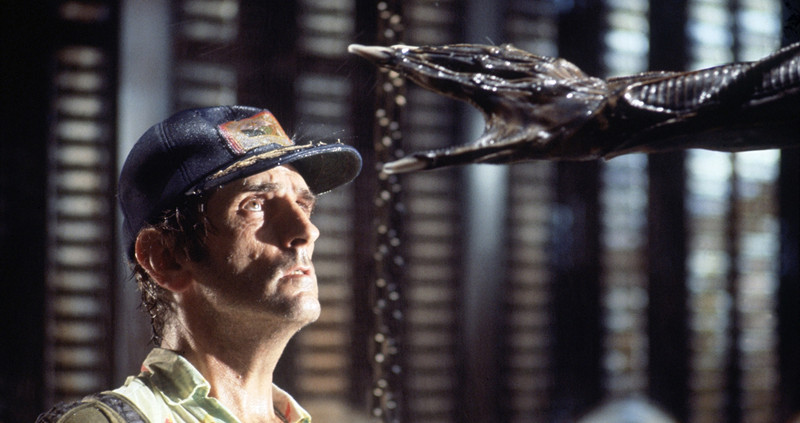
Taking the idea of the haunted house and transferring it to a spaceship worked wonders for Ridley Scott. His original film has stood the test of time and still looks fresh and contemporary today. It is also full of terrifying moments.
The sequence that stands out from all the others in terms of tension, ahead of Ripley ever so slowly climbing into her spacesuit at the end, is Tom Skerritt as Captain Dallas creeping through the service vents. He has the light provided him by his flamethrower to light the way, just like someone creeping through the corridors of a haunted mansion with a candle. He also has Veronica Cartwright’s Lambert in his headset, updating him on the alien’s movements.
The ominous, repetitive bleeps which seem childish like something out of an old video game tell the story of the creature’s movements, ever closer to Dallas. He looks around him, completely done with the idea of looking for the thing and resolves to get out of the vents before it finds him. Lambert’s desperate voice on the intercom substitutes well for what we can imagine Dallas’ inner monologue being. There’s a jump scare at the end, but just like Mulholland Drive mentioned above, it’s the build-up that counts.
9. Border crossing – Sicario (2015)
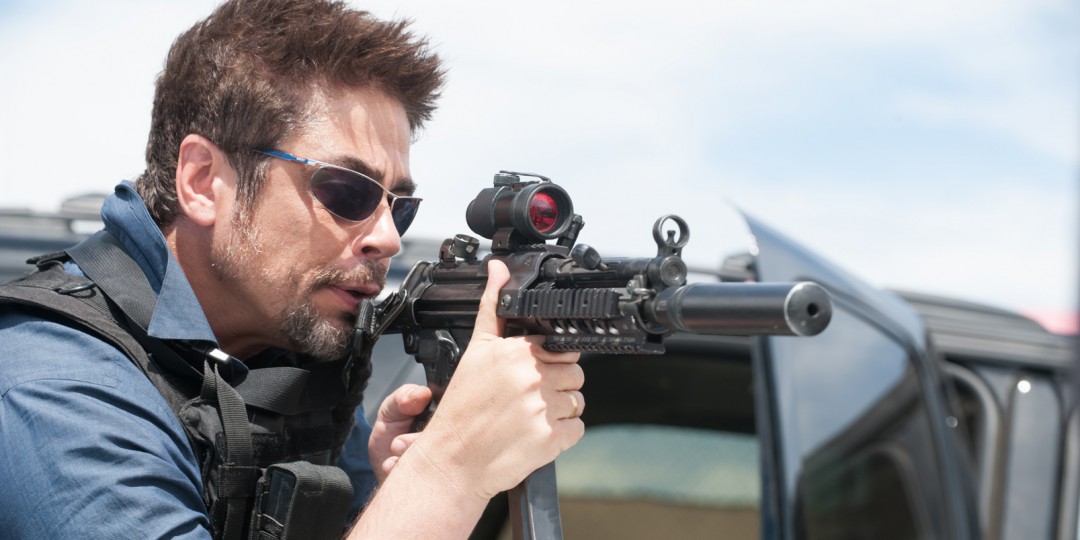
A broken down vehicle has turned the Mexico-USA border crossing one big traffic jam. Into this hold up comes a convoy of FBI and DEA agents transporting a fugitive. All around are potential hostiles and the team must constantly re-evaluate their position and options as they are hemmed in by traffic all around them. All around the convoy is the potential for death, but from where will the attack come? The team’s rules of engagement make it difficult for them to assert themselves but they leave their vehicles and spread out to the potential threats, initiating one tense standoff after another.
Legendary Director of Photography, Roger Deakins, worked out the scene with the film’s director, Denis Villeneuve mixing overhead shots of the actual border with others filmed in Mexico City. The whole scene may not have come together had it not been for permits granted at the last minute. This is a truly magnificent scene that goes from a race through the streets of Juarez to the gridlock of the border. Things erupt into moments of violence which are presented as shockingly matter of fact. Never in the history of film making has a traffic jam been this exciting.
8. In the bathtub – Training Day (2001)
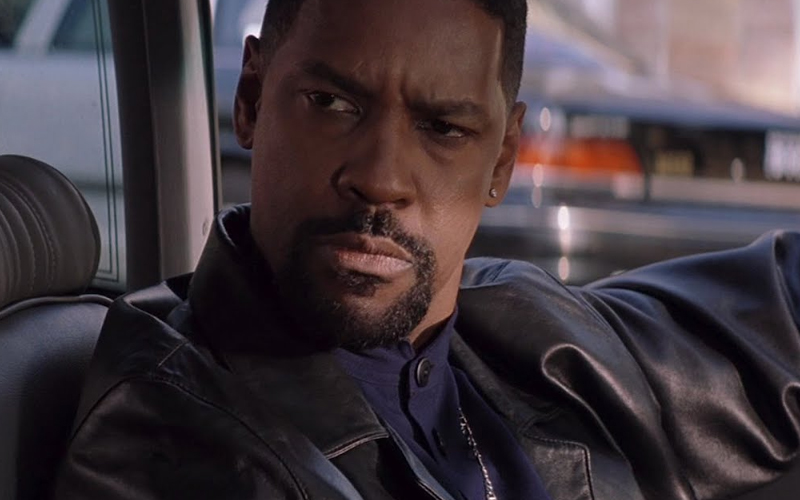
Ethan Hawke’s Officer Jake Hoyt is left in the care of some gangsters who have instructions to kill him at the behest of Denzel Washington’s Alonzo Harris. They play a game of cards which becomes more and more tense as Jake figures out that he has been double crossed and left for dead. He thinks he has the ability to catch his captors off guard and hatches an impromptu bid for escape.
After a brief fight, he is dragged into the bathroom and thrown into the tub to await a shotgun blast. He begs for his life and it looks like there is absolutely no way out for him. Then the gangsters discover a wallet he found after saving a young girl earlier in the day. Things can go one way or the other from this point onwards.
This is such a fantastic scene. Ethan Hawke is quickly overwhelmed and plays the desperate, wide-eyed victim extremely well. The dim lighting and claustrophobic setting of the bathtub, along with the end of the shotgun barrel moving around Jake’s face make for a tremendous sense of immediacy. Director Antoine Fuqua attempted to keep Hawke off balance during the card game scene by giving extra instructions to his captors but leaving him in the dark as to what they were.
7. It can’t see us if we don’t move – Jurassic Park (1993)
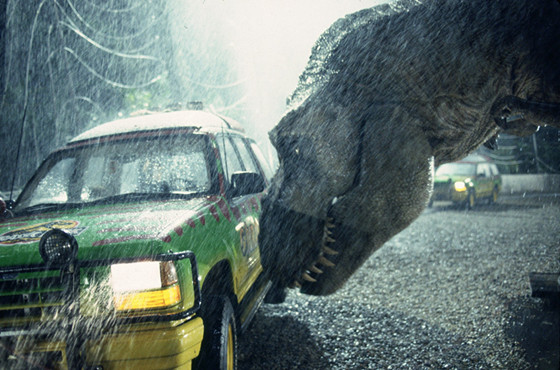
Steven Spielberg’s dinosaur adventure film delivers so much in the way of tension. The ‘raptors in the kitchen’ scene is a particularly good and well-quoted example of this. Out of all the tense moments in the film, however, the first sight of that T-Rex in all its glory is impossible to top.
This was a landmark moment in the history of special effects; the thing was created so well by the legendary Stan Winston and with such heft (a quality sorely lacking in most modern CGI creations) that it genuinely appears real, even in the computer generated long shots. You can feel every one of its toes sinking into the mud. Darkness, rain and thunder all add to the way the scene is put together. The build up to the scene is masterful, with rings of vibration in a cup of water telling the audience and characters that something big is coming. These ripples were more difficult to produce than you might imagine.
In the end, it took someone underneath the car with a guitar string tied to the cup to make it happen. The most tense part of the scene is where Sam Neill’s Dr Alan Grant is trying to rescue the children form the overturned jeep. As it is pushed around by the T-Rex, Grant and the Lex (Ariana Richards) have to remain absolutely still to avoid alerting it to their presence. Seeing that huge head full of foot-long teeth so close to them that its breath blows off Grant’s hat is what the phrase edge-of-your-seat was invented for.
6. Fumbling in the dark – The Silence of the Lambs (1991)
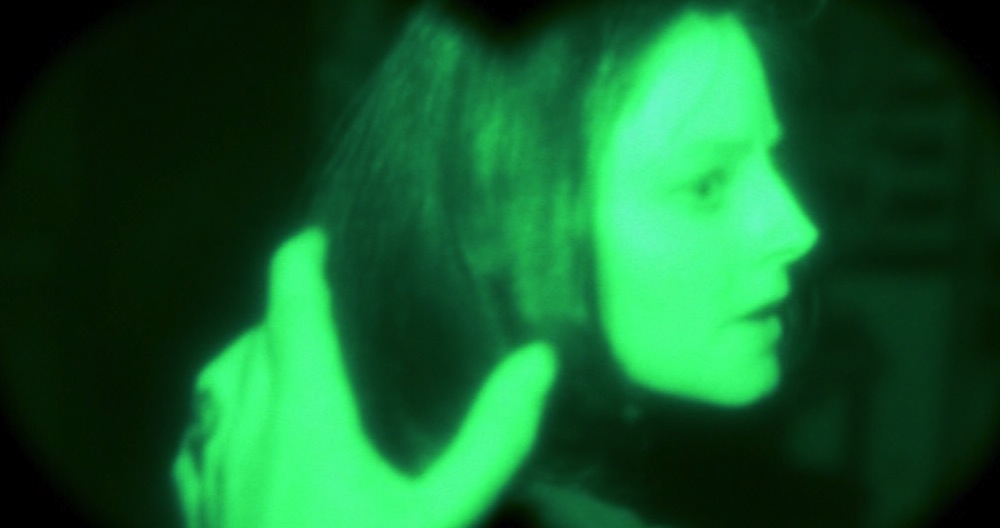
One way to build tension is to give the antagonist the upper hand in a situation. In this scene, Jodie Foster’s Agent Starling shakes in the darkness with her gun hand outstretched as she tries to find the serial killer Buffalo Bill (Ted Levine) in his pitch black basement. All the while, her tentative fumblings are being observed by the killer through his night-vision goggles. He gazes at her helpless form, plays with her, touches her hair, before we see him raise his own huge gun to her head.
The FBI, despite their high praise for the film’s depiction of serial killer case work, had an issue with this scene, as it would be completely against protocol for an inexperienced agent to go into a dangerous situation like this alone. Johnathan Demme, the director, refused to change it for them, insisting that it was the important climax of the film. A lot of the tension in the scene comes from the audience’s knowledge of the kind of character that Ted Levine created in Buffalo Bill. He had prepared for the role by studying serial killers like Gary Heidnik, who kept women in his basement just as Bill does.
Tension also comes from the extensive set of the maze-like basement dungeon, which was created inside an old turbine factory. Most of all, however, in a film where we largely see things literally through Starling’s eyes, with many characters looking at the camera as they address her, the tension comes from us being on the outside for once, helpless, regarding her through the killer’s eyes.
5. Funny how? – Goodfellas (1990)

This scene has some similarities with Javier Bardem and the gas station proprietor above. What marks this out is the fact that, unlike Chigurh, Joe Pesci’s character, Tommy DeVito is messing with Ray Liotta’s Henry Hill just for the sake of it. Pesci creates a character so difficult to read that no-one has a clue whether he’s serious or not. When he should be joking he’s serious and when he should be serious, he jokes.
After telling a funny story about a time that he was arrested, Hill tells DeVito that he’s a funny guy. What should be an innocuous, even flattering comment is seemingly taken by DeVito as a slur against him and the laughter of the group fades away dramatically. DeVito then launches into an angry set of questions about Hill’s motivations for saying that he’s funny. The audience at this point has no idea whether he’s serious or not. The safe bet with DeVito is to assume that he’s serious and hope for the best.
The scene was based on a real story that Pesci told Martin Scorsese about a similar interaction that he had with a real mobster. Scorsese didn’t include it in the script and only he, Pesci and Ray Liotta had an idea what was coming. Their reactions to the events unfolding are therefore much more genuine. That fading of the laughter has a real edge to it that is recognisable to anyone who has ever seen a joke go down the wrong way.
4. Hans Landa comes to call – Inglorious Basterds (2009)
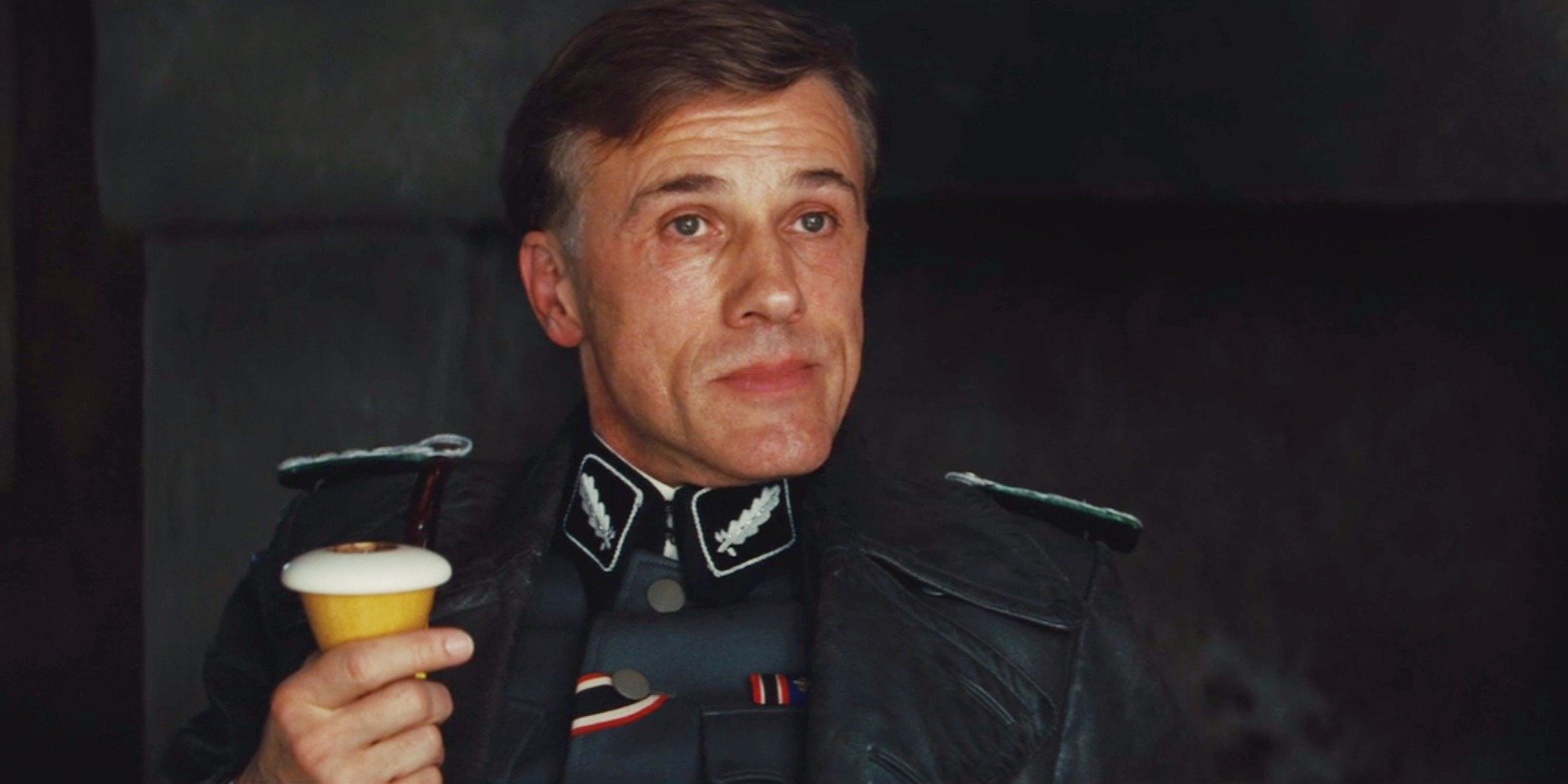
Colonel Hans Landa of the SS (Christophe Waltz) comes to visit a farmer (Denis Menochet) and his family, extending a cordial hand and availing himself of some of their milk. The family are rightly suspicious of his pretentions of warmth and what ensues is an incredibly tense conversation. The farmer knows everything about who Landa is: a feared hunter of Jewish families hiding from the Nazis.
The scene is marvellous, the two playing out a pantomime, each going through the motions of civility to each other. Tarantino increases the tension magnificently by panning down mid-scene to the Dreyfus family hiding beneath the floorboards. Waltz takes most of the plaudits for this scene as he has most of the dialogue.
It is Menochet, however, with his poker face and monosyllabic speech who makes the tension all the more palpable, especially when this dissolves into tears at the climax of the scene when he realises the hopelessness of his position. You can tell he is disgusted by the Nazi officer but he is forced to play along with entertaining the man throughout: a great scene. Although we know the probable outcome from very near its beginning, we are still held in thrall until the end.
3. Chasing the Train – The French Connection (1971)
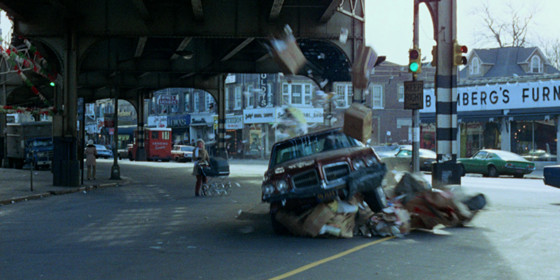
As far as car chases go, this is one of the most memorable there is. The reason it is so tense has nothing to do with whether Jimmy ‘Popeye’ Doyle (Gene Hackman) is going to catch up with his quarry in the elevated train. No, the tension comes from knowing that all his attention is focussed on the train and none of it on the road in front of him. The audience knows that it’s only a matter of time before his inattention leads to something disastrous. The real life history of this scene makes it all the more compelling when you rewatch.
The film makers did not manage to secure the permits they needed and therefore most of it was filmed on uncleared roads in New York. Most of the traffic control was done by the assistant directors, accompanied by off-duty police officers. Hackman did some of the driving himself but the most dangerous parts were left to stuntman Bill Hickman.
The film’s director, William Friedkin, operated the camera from the backseat himself; he wouldn’t allow any of the actual cameramen to do this as they were all married with children. The chase continued out of the controlled areas and what you see on screen is unsuspecting drivers and pedestrians trying to get out of the way. One part of the scene, in which Hackman’s car crashes into a white Ford, was a real accident during filming which involved a local man on his way to work. It was left in because it was authentic.
2. Ringing the doorbell – Leon (1994)
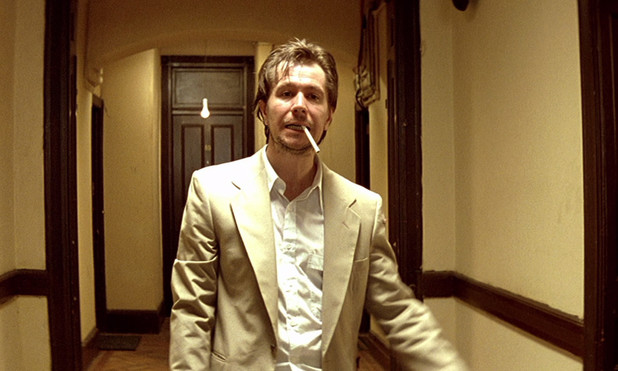
Eric Serra’s score helps build up this scene brilliantly. We see Natalie Portman as Matilda emerge from the grocery store with milk for her new hero and role model, Jean Reno’s Leon. Her childhood is shattered as she turns the corner at the top of the stairs and sees the bloodbath that she has narrowly missed. Her deadbeat father and the rest of her family have been massacred by Gary Oldman’s DEA goon, Norman Stansfield, and his team. She can’t stop or turn around or she’ll be discovered by the one standing guard outside her door.
Even when she hears the voices from within telling of the murder of her little brother, the only family member that she actually liked, she has to keep walking on without showing any emotion. Where does she walk? To the only place that she can think of: Leon’s apartment at the end of the hall. She rings on the doorbell desperately while trying to remain calm to the dangerously curious agent at her own door.
We see her as Leon does, through the spyglass in the door. He has no reason to open the door; he risks exposure for himself and more trouble than he needs. The audience is begging him to open the door and let her in. The score plays a big part in this scene but the lion’s share of the credit has to go to Portman for her acting throughout. Her face is a mask of desperation that tugs on our heartstrings as she whispers, “Please open the door.”
1. Searching the apartment – Rear Window (1954)
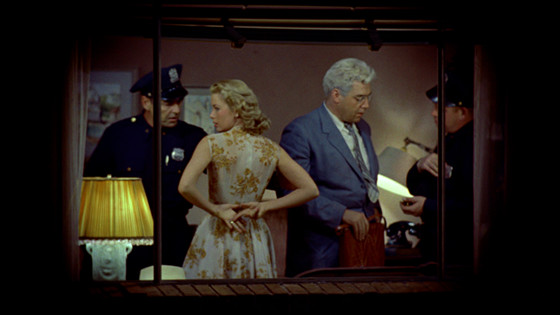
James Stewart’s injured photographer, LB Jeffries, is confined to his apartment with only the carryings on of his neighbours to keep him amused. As he watches, he uncovers what he suspects is a murder by one of them: Lars Thorwald (Raymond Burr). He sends his girlfriend Lisa, played by Grace Kelly, to break into Thorwald’s apartment and look for clues.
As she does so, however, we see Thorwald returning early from the errand he has been sent on. The beauty of this scene is that the camera stays helplessly stuck in the apartment with James Stewart. We, the audience, are stuck there, as distanced and unable to help as he is. It is this camera work, combined with Stewart’s acting, skilful facial expressions and gestures, which makes this scene so memorable. The camera shows us Grace Kelly searching for a hiding place when Thorwald returns but we don’t actually see her find one because this is hidden from us by the wall. We don’t know how exposed she is.
The music also helps in this scene, playing on as calm as it was throughout the entire scene even when things reach their tensest tense point. This is the genius of Alfred Hitchcock at work, combined by the superlative talent of James Stewart. We feel everything we’re supposed to feel. We’re made to feel as helpless as he does, stuck in that chair in the apartment, powerless. This is the tensest scene in motion picture history.
Author Bio: Richard Austin is a Primary School Deputy Headteacher who’s just finished his first novel and is saving up to get it edited. When he was a kid, he used to keep a little book of the films he went to see at the cinema, giving them ratings out of 5, which his family and friends find highly amusing to this day! He also has a website where he writes his random thoughts about science fiction.